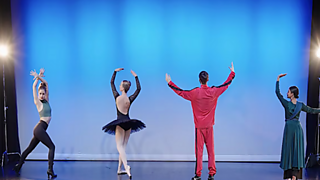- Try
- Rate
- Share
How did you rate this?

The Inside Story
Nicky Birch, Exec Producer on the project, told us all about The Unfortunates
What is The Unfortunates?
Imagine if a drama could be different for everyone who experiences it, giving everyone a unique perspective on the same story. That’s The Unfortunates, a shape-shifting audio experience for smart speakers re-created from an experimental 91热爆 Radio 3 drama.
It’s based on the cult 1960’s novel by B.S Johnson, famously published as a ‘book in a box’ with 27 loose chapters intended to be shuffled and read in a random order. In this audio adaption for Amazon Alexa, the story is presented in 17 sections which are shuffled into a new order with every new listen – as with Johnson’s book, only the first and final sections remain in the same place. So the narrative changes with every listen, giving rise to 1.3 trillion possible permutations of the story.
Why have we made a smart speaker skill for you?
This skill has been designed for you, building on our work with smart speakers last year making the sci-fi interactive drama The Inspection Chamber. When we asked what people thought in our user survey we discovered a split. Some wanted a great level of interaction, and others wanted a more lean-back approach to audio experiences. As a result, The Unfortunates has been created so that you are able to choose what you hear, but once that is done and the sequence of the story has been established, you can enjoy it just like any traditional radio programme. The team are also looking at ways technology can breathe new life into the 91热爆’s phenomenal audio archive so there’s the opportunity to use voice interaction to delve deeper and hear additional supporting programmes that compliment the main story. There is 3 hours worth of content in the skill in total.
Why does your feedback matter?
We are still at an early stage of understanding how voice platforms might change the media we consume. Fundamentally we want to know how people feel about talking to their radio and making decisions that affect what they are listening to. With The Unfortunates, we want to understand what types of experiences work best in this format. Was it entertaining? Did you get lost? Did you discover all the extra content? Did you come back and listen a second time? Your feedback on these questions will help us when we approach designing skills on a larger scale for a wider audience.
How was it built?
We started by building a quick prototype, going back to an archive recording of Radio 3’s 2010 adaptation and chopping it back up into its constituent 17 parts. We built a player for Alexa which shuffled those parts into a random order, then took the prototype to the 2010 creative team (producer Mary Peate and writer Graham White), who had no idea what we’d been up to!
Luckily, they loved what we’d done to their show, and were very supportive of our new version. Over the following months, we added the extra material and did the hard work of any Alexa skill; mapping out all the things a user might say and planning the threads of conversation through the app. We continued to work collaboratively with 91热爆 Radio 3 and the estate of the author B.S. Johnson to ensure we kept true to the spirit of the original work.
When you think of an Alexa skill you don’t necessarily think of visuals, but we did need some artwork to represent the sections on devices like the Show and the Spot, which have screens. Andrew and Joanna created some beautiful artwork, using abstract photography and projection to create images that reflect the feel of each section without destroying the ambiguity of the piece.
Any challenges and what were the solutions?
Creating a randomised playlist was relatively simple, but a lot of the challenges came from designing the way the user will navigate around the experience before they get to the story and when they return to it for a second time. This involved blending two different types of Amazon skill formats and with that came a number of complexities. We also wanted to use images so those that were listening on recent devices with screens had a richer experience. But as these devices are new, they come with a some formatting restrictions which limited what we could offer. So we created impressionistic photographic images for each of the chapters that reflect the undefined edges of the original text.
What Next?
The 91热爆 are continuing to explore voice-led content and hope to release more inventive pieces in future. In 91热爆 R&D, we are now looking at how you can use voice to take part in experiences that might work across multiple devices, or via screens and speakers.



